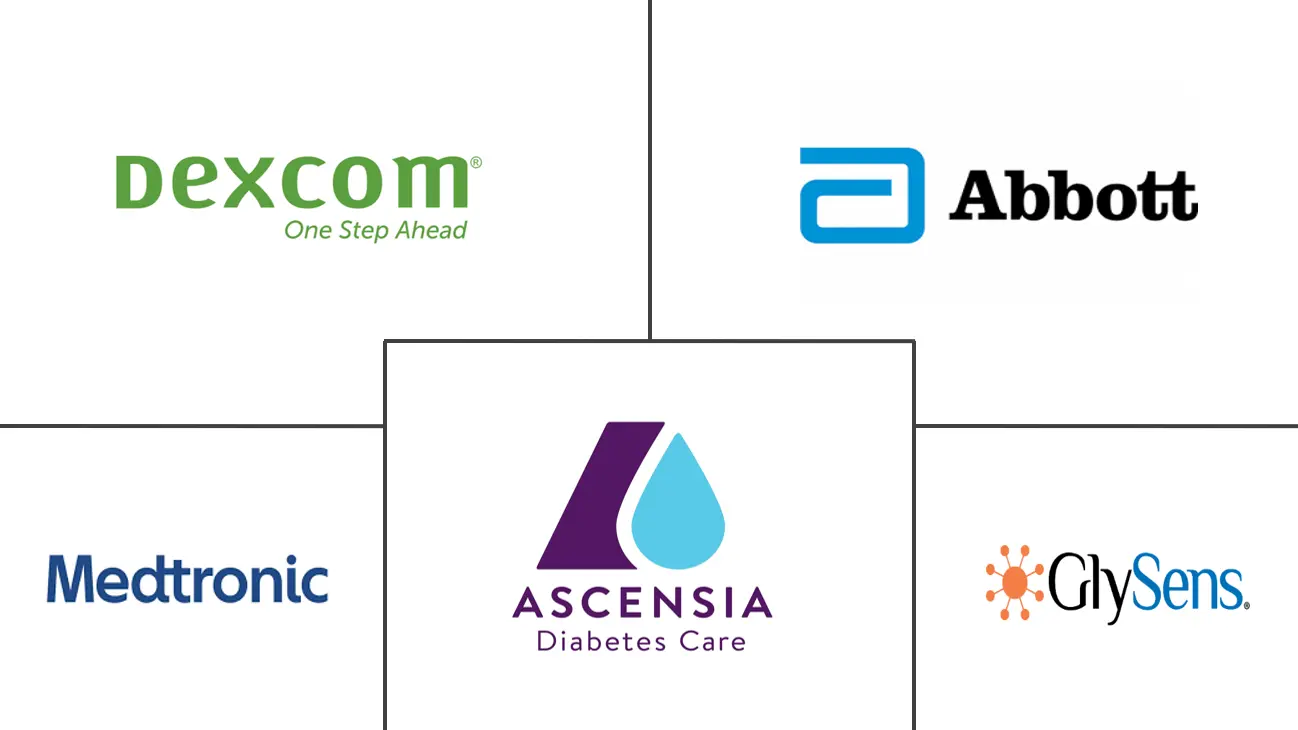France Continuous Glucose Monitoring Market Size and Share
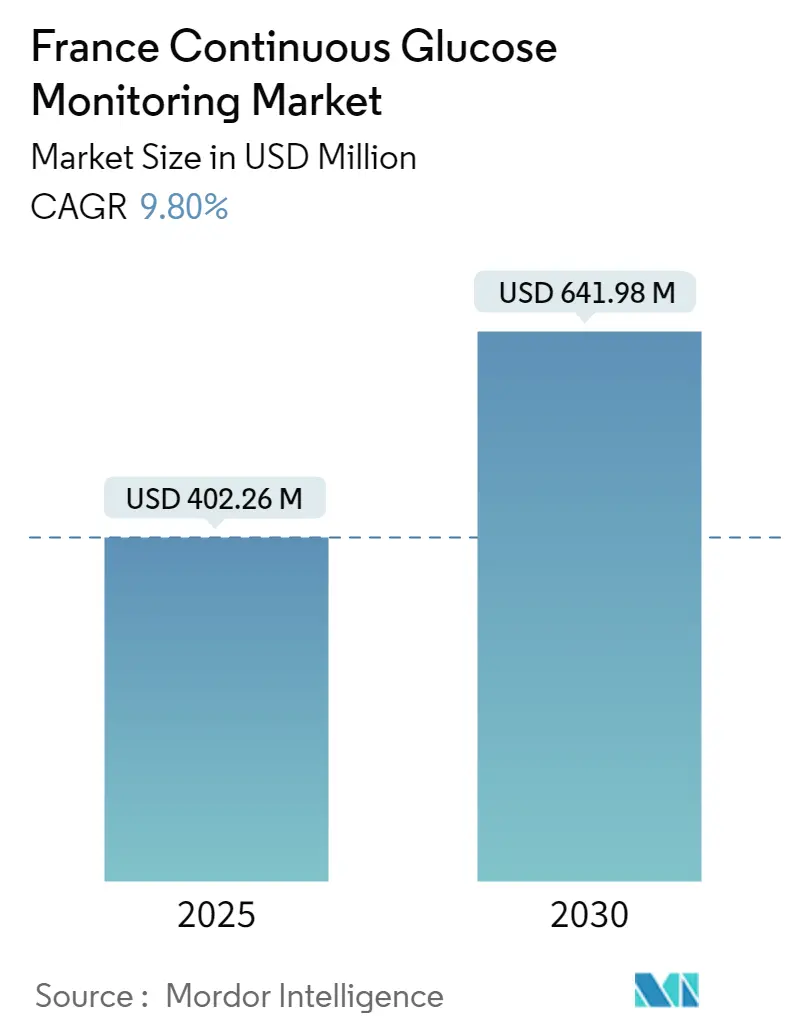
France Continuous Glucose Monitoring Market Analysis by Mordor Intelligence
The France Continuous Glucose Monitoring Market size is estimated at USD 402.26 million in 2025, and is expected to reach USD 641.98 million by 2030, at a CAGR of 9.8% during the forecast period (2025-2030).
Diabetes was considered a major risk factor for developing SARS-CoV-2 infections during the COVID-19 pandemic as it was associated with a higher risk of infections and a higher risk of developing severe forms of COVID-19-related pneumonia. Various underlying comorbidities, such as obesity, hypertension, cardiovascular diseases, chronic kidney disease, and immune dysfunction, were major factors susceptible to infectious complications. Following a COVID-19 infection, various studies suggested that reduced numbers of insulin secretory granules in beta cells and impaired glucose-stimulated insulin secretion were observed in the affected patients. In addition, post the pandemic, some patients developed insulin resistance and had elevated blood glucose levels, although they had no previous history of diabetes.
Continuous glucose monitoring (CGM) devices help people manage Type 1 or Type 2 diabetes with fewer fingerstick tests. A CGM device consists of a sensor that is inserted just under the skin and measures glucose levels 24 hours a day. A transmitter sends results to a wearable device an integrated insulin pump, a smart insulin pen, or a cell phone to help provide actionable insights. Tracking blood glucose levels assists diabetes patients with the insulin required by the body and when to prevent high (hyperglycemia) or low (hypoglycemia) blood sugar levels, which can have serious side effects and even be life-threatening when not treated quickly.
Diabetes is associated with a higher risk of many health complications. People with diabetes face a higher chance of experiencing serious complications. While comparing the population with diabetes with those without diabetes, people with diabetes have an increased risk of being hospitalized and, thus, are expected to incur more healthcare expenses than non-diabetic people. Thus, it is essential for diabetics to effectively monitor and manage their blood sugar levels through technologies such as continuous glucose monitoring. Moreover, the reimbursement policy and the pricing policy in France are highly regulated, which drives the market and increases the adoption rate of new and advanced technologies.
Further, in France, the health insurance support service Sophia provides self-management education for adults living with diabetes, which helps people living with diabetes to better understand their conditions and ways to manage them, adjust their lifestyle to reduce the risk of complications and improve the quality of life. The Fédération Française des Diabétiques provides peer-to-peer support through a dedicated BPE service (bénévole patient expert). Thus, owing to the aforementioned factors, the market for continuous glucose monitoring diseases is expected to witness growth over the forecast period.
France Continuous Glucose Monitoring Market Trends and Insights
Rising diabetes prevalence
The diabetes population in France is expected to grow by about 2.9% over the forecast period.
According to the International Diabetes Federation's latest estimates, the prevalence of diabetes in adults in France was approximately 8.6%, and about 27.9% of the population was undiagnosed.
In France, insulin and other related supplies and technologies are free of charge for all patients with diabetes. As per national guidelines, screening for diabetes-related complications is available in France except for the diabetes foot. A five-year health plan at the regional level supports the national health policy guidelines. Further, the French health benefit basket plays an important role; diabetes is one of the 30 chronic diseases covered 100% by statutory health insurance under the ALD scheme (affections de longue durée). For those not covered under ALD, a share of the official health care tariff is paid by the patient and varies depending on the category of goods and care.
Diabetes is essentially a data management disease, as the real-world health and treatment data provides integrated and personalized chronic disease management. Both patients and diabetes care providers use continuously collected metabolic, treatment, and lifestyle data in the process of joint decision-making on treatment. France has a working diabetes registry for people living with T1D and electronic health records. E-health is adopted mainly in the context of video consultations and electronic prescriptions.
Further, digital health technologies, including digital health applications, support diabetes self-management. The vast range of apps in the diabetes field supports the adoption of lifestyle interventions for the prevention and management of diabetes, the evaluation of blood glucose control quality, and the dosing of insulin. Integration of Continuous Glucose Monitoring with insulin calculators, automated insulin titration software, and remote coaching are further developments that provide patients with poorly controlled diabetes additional support needed to improve critical outcomes, thereby enhancing the market prospects in the years to come.
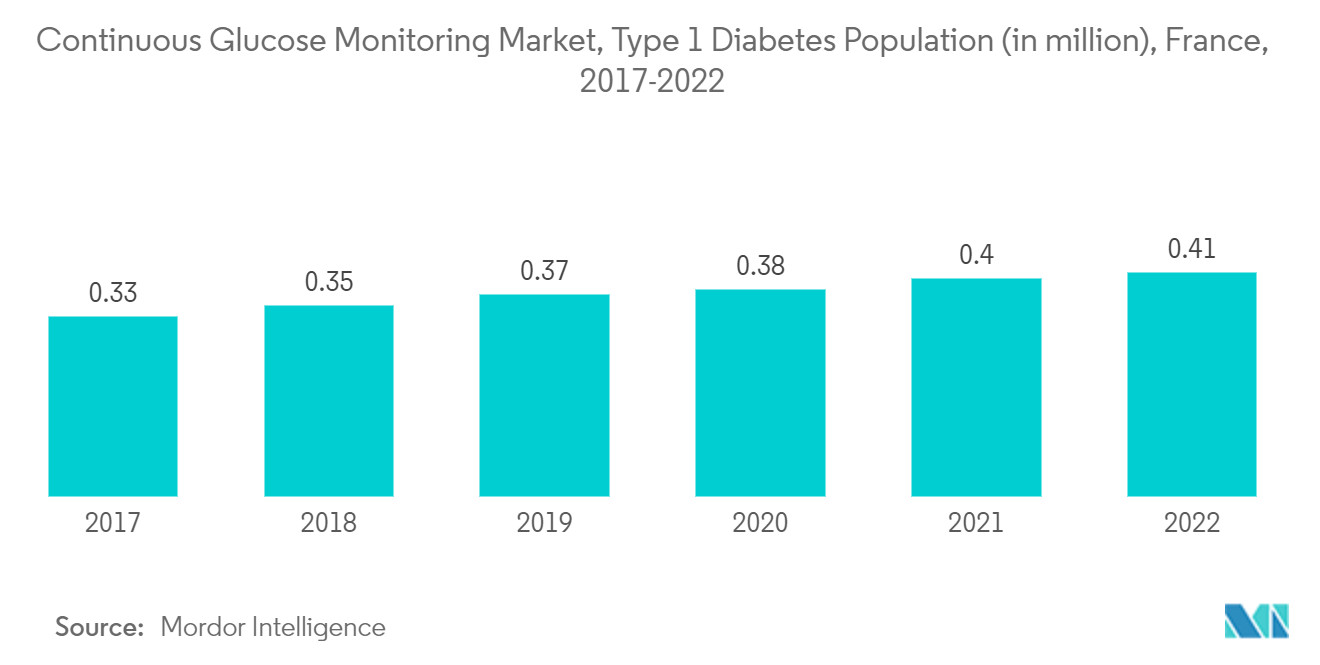
The sensors segment is expected to hold the highest share over the forecast period
Continuous glucose monitoring sensors use glucose oxidase to detect blood sugar levels. Glucose oxidase converts glucose to hydrogen peroxidase, which reacts with the platinum inside the sensor, producing an electrical signal to be communicated to the transmitter. Sensors are the most important part of continuous glucose Monitoring. Technological advancements to improve the accuracy of the sensors are expected to drive segment growth during the forecast period.
Researchers are trying to explore alternatives to electrochemical-based glucose sensors and create more affordable, minimally invasive, and user-friendly CGM sensors. Optical measurement is a promising platform for glucose sensing. Some technologies have been reported to have high potential in continuous glucose sensing, including spectroscopy, fluorescence, holographic technology, etc. Eversense, a CGM sensor based on fluorescence sensing developed by Senseonics Company, presents a much longer lifespan in comparison with electrochemical sensors.
Psychological support for people with diabetes is available as part of an experimental program in the country. The frequency of monitoring glucose levels depends on the type of diabetes, which varies from patient to patient. Type-1 diabetic patients need to check their blood glucose levels at regular intervals to monitor their blood glucose levels and adjust the insulin dosing accordingly. The expenditure incurred by Type-1 diabetic patients on these devices is nearly double that of Type-2 diabetics. The current CGM devices show a detailed representation of blood glucose patterns and tendencies compared to a routine check of glucose levels at set intervals. Furthermore, the current continuous glucose monitoring devices can either retrospectively display the trends in the levels of blood glucose by downloading the data or give a real-time picture of glucose levels through receiver displays. The newest CGM models, the Abbott Freestyle Libre 3 and the Dexcom G7, overcame many technical barriers. Continuous glucose monitoring devices are becoming cheaper with the advent of new technologies, like cell phone integration, which is likely to drive the segment growth during the forecast period.
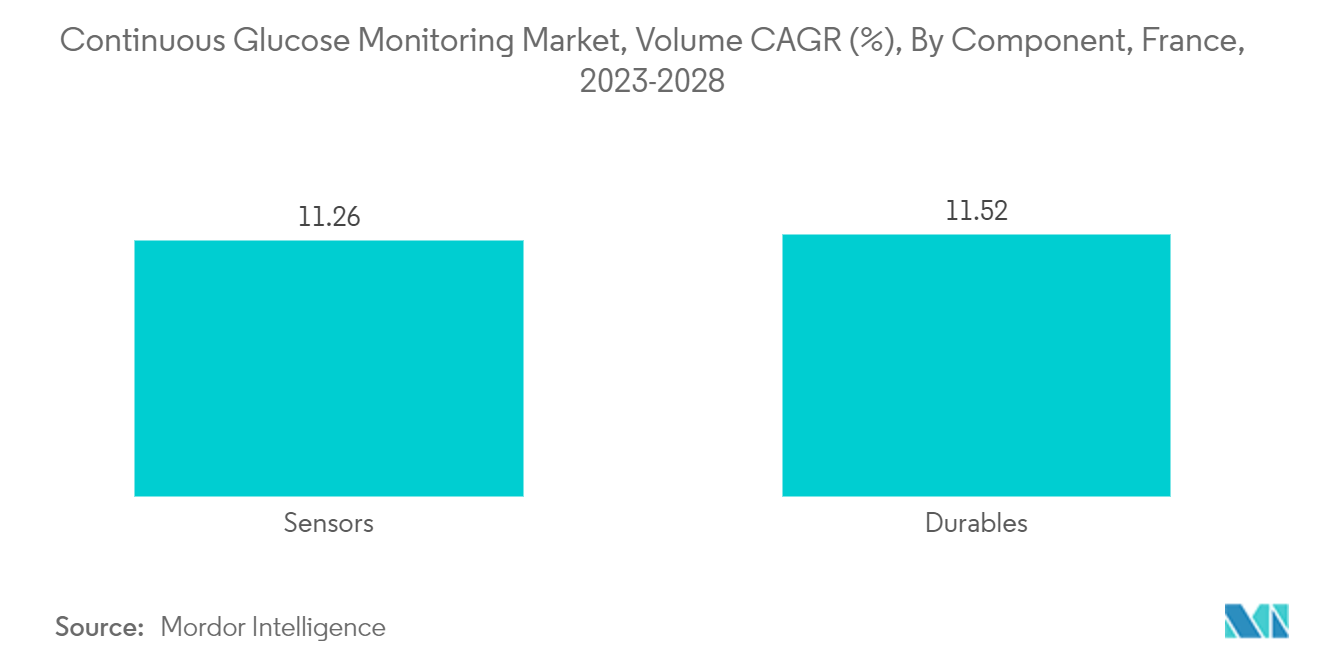
Competitive Landscape
The French continuous glucose monitoring market is consolidated, with few significant players. There have been constant innovations driven by manufacturers such as Abbott, Dexcom, Medtronic, etc., while also adhering to organic growth strategies, which is evident from the R&D spending of these companies.
France Continuous Glucose Monitoring Industry Leaders
-
Abbott
-
Dexcom
-
Medtronic
-
Ascensia
-
Glysens
- *Disclaimer: Major Players sorted in no particular order
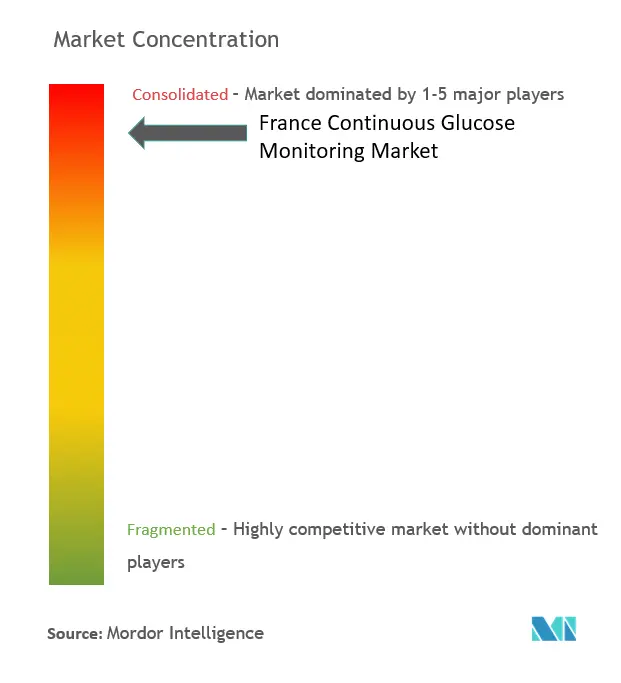
Recent Industry Developments
- September 2023: DexCom announced the availability of its Dexcom ONE real-time CGM sensor via reimbursement, in France. Dexcom’s announcement brings the company’s real-time CGM technology to half a million more people with diabetes in France. Specifically, access is now secured to the Dexcom ONE sensor for all patients with type 1 and type 2 diabetes, two years and older, who are undergoing intensive insulin therapy (by external pump or >3 injections per day).
- June 2023: Abbott announced that the French health authority approved the expansion of reimbursement coverage for its FreeStyle Libre 2 system to include all people who use basal insulin as part of their diabetes management. FreeStyle Libre 2 was previously covered only for people with Type 1 and Type 2 diabetes who require intensive insulin therapy. The expanded reimbursement enables more people living with diabetes in France to access the latest CGM technology that can help them make informed health and lifestyle decisions.
France Continuous Glucose Monitoring Market Report Scope
Continuous glucose monitoring devices are used to diagnose both hyperglycemic and hypoglycemic conditions in diabetic patients throughout the day. The France continuous glucose monitoring market is segmented into components (sensors and durables (receivers and transmitters)).
The report offers the value (in USD) and volume (in units) for the above segments.
| Sensors |
| Durables |
| Component | Sensors |
| Durables |
Key Questions Answered in the Report
How big is the France Continuous Glucose Monitoring Market?
The France Continuous Glucose Monitoring Market size is expected to reach USD 402.26 million in 2025 and grow at a CAGR of 9.80% to reach USD 641.98 million by 2030.
What is the current France Continuous Glucose Monitoring Market size?
In 2025, the France Continuous Glucose Monitoring Market size is expected to reach USD 402.26 million.
Who are the key players in France Continuous Glucose Monitoring Market?
Abbott, Dexcom, Medtronic, Ascensia and Glysens are the major companies operating in the France Continuous Glucose Monitoring Market.
What years does this France Continuous Glucose Monitoring Market cover, and what was the market size in 2024?
In 2024, the France Continuous Glucose Monitoring Market size was estimated at USD 362.84 million. The report covers the France Continuous Glucose Monitoring Market historical market size for years: 2018, 2019, 2020, 2021, 2022, 2023 and 2024. The report also forecasts the France Continuous Glucose Monitoring Market size for years: 2025, 2026, 2027, 2028, 2029 and 2030.
Page last updated on:
France Continuous Glucose Monitoring Market Report
Statistics for the 2025 France Continuous Glucose Monitoring market share, size and revenue growth rate, created by Mordor Intelligence™ Industry Reports. France Continuous Glucose Monitoring analysis includes a market forecast outlook for 2025 to 2030 and historical overview. Get a sample of this industry analysis as a free report PDF download.
